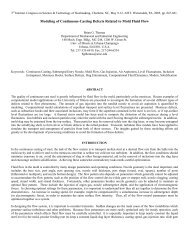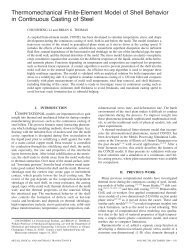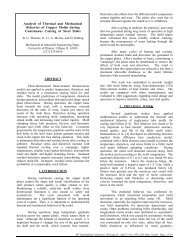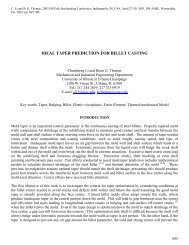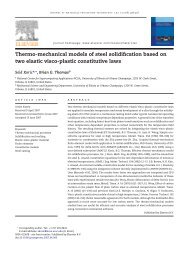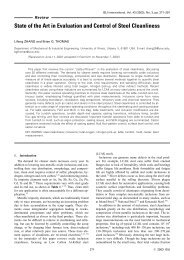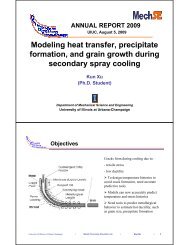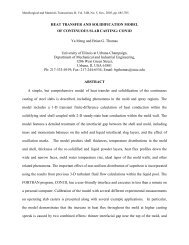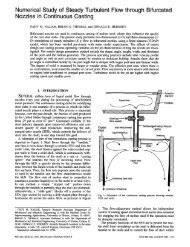1 Clogging in Continuous Casting Nozzles K. G. Rackers and B. G. ...
1 Clogging in Continuous Casting Nozzles K. G. Rackers and B. G. ...
1 Clogging in Continuous Casting Nozzles K. G. Rackers and B. G. ...
Create successful ePaper yourself
Turn your PDF publications into a flip-book with our unique Google optimized e-Paper software.
The second condition considered represents a tundish <strong>and</strong> submerged entry nozzle with a limit<strong>in</strong>g<br />
amount of clogg<strong>in</strong>g (i.e., the required slide gate position to ma<strong>in</strong>ta<strong>in</strong> cast speed is 100%). It is noted<br />
here that the pressure everywhere rema<strong>in</strong>s above atmospheric. The f<strong>in</strong>al case considered represents<br />
limit<strong>in</strong>g clogg<strong>in</strong>g <strong>in</strong> the tundish nozzle <strong>and</strong> no clogg<strong>in</strong>g <strong>in</strong> the submerged entry nozzle (e.g., the<br />
condition after a submerged entry nozzle replacement). For this case the entire tundish nozzle is below<br />
atmospheric pressure.<br />
2.2.3. Fraction Alum<strong>in</strong>a Captured by Nozzle<br />
When no clogg<strong>in</strong>g countermeasures are employed, nozzle clogg<strong>in</strong>g has been observed to limit<br />
sequence cast<strong>in</strong>g to 1-3 heats [1, 45]. Assum<strong>in</strong>g 250 ton heats <strong>and</strong> a 30 ppm comb<strong>in</strong>ed oxygen<br />
concentration <strong>in</strong> the tundish, 32 kg of alum<strong>in</strong>a will pass through the nozzles <strong>in</strong> two heats.<br />
The density of a pure alum<strong>in</strong>a clog will depend on the pack<strong>in</strong>g efficiency of the deoxidation<br />
products. If the clog is modeled as a group of 10 micron diameter f<strong>in</strong>ger-like structures (see Figure 15)<br />
<strong>and</strong> the critical distance between the f<strong>in</strong>gers for ejection of molten steel is calculated [10], the volume<br />
fraction of alum<strong>in</strong>a <strong>in</strong> a “pure alum<strong>in</strong>a” clog is 17%. Consider<strong>in</strong>g a two str<strong>and</strong> caster [1] hav<strong>in</strong>g 1 m<br />
long nozzles with 20 mm thick clogs, the amount of alum<strong>in</strong>a with<strong>in</strong> the clogs is calculated to be 5.1 kg.<br />
Tak<strong>in</strong>g the ratio of the deposited alum<strong>in</strong>a to the alum<strong>in</strong>a throughput, it is seen that <strong>in</strong> these severe<br />
clogg<strong>in</strong>g situations about 16% of the alum<strong>in</strong>a pass<strong>in</strong>g through the nozzle is deposited (assum<strong>in</strong>g the clog<br />
is composed of deoxidation products). This <strong>in</strong>dicates that <strong>in</strong> the absence of clogg<strong>in</strong>g countermeasures<br />
(e.g., argon <strong>in</strong>jection), transport of the <strong>in</strong>clusions to the nozzle wall is fairly efficient.<br />
2.2.4. Relationship between Reoxidation <strong>and</strong> <strong>Clogg<strong>in</strong>g</strong> Rate<br />
Nitrogen pickup between the tundish <strong>and</strong> mold can be used to quantify the reoxidation occurr<strong>in</strong>g<br />
<strong>in</strong> the nozzle [58]. Prior to efforts to improve nozzle air-tightness, McPherson [58] measured nitrogen<br />
pickup values of 5 ppm. Consider<strong>in</strong>g 250 ton heats <strong>and</strong> assum<strong>in</strong>g all the aspirated oxygen forms<br />
alum<strong>in</strong>a, this reoxidation source would generate 1.4 kg of alum<strong>in</strong>a <strong>in</strong> two heats, a substantial fraction of<br />
the above calculated clog mass.<br />
The aspirated oxygen also accelerates the deposition of deoxidation products by creat<strong>in</strong>g a<br />
surface tension gradient around the deoxidation product which <strong>in</strong> turn causes a net force on the particle<br />
<strong>in</strong> the direction of the wall. Consider<strong>in</strong>g a l<strong>in</strong>ear variation <strong>in</strong> surface tension with position, <strong>and</strong> assum<strong>in</strong>g<br />
Stokes drag on the particle, the surface tension <strong>in</strong>duced particle velocity is:<br />
V = -2 mγ R<br />
9 µ<br />
where, V = particle velocity<br />
mγ = surface tension gradient<br />
R = particle radius<br />
µ = viscosity of steel<br />
10



